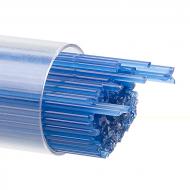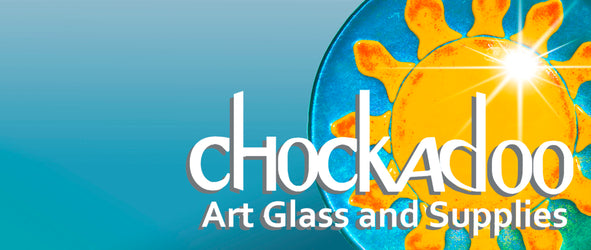
Egyptian Blue Opaque Bullseye Stringer 164
Threads of glass pulled from re-melted Bullseye Compatible sheet. For use in kilnforming or torchworking.
Stringers come in 1 or 2-mm thicknesses and are approximately 451 mm long.
We have 1mm stringers in a pack of 10 or a 1mm tube with approximately 120 pieces. The tubes are a clear plastic cylinder 457 mm long and 19 mm in diameter.
We have a 2mm stringer available in a tube only and has approximately 50 pieces.
Bullseye is 90COE and isn't compatible with Effetre or Vetrofond Rods. Annealing Temperature range is 505- 520 Celsius
Contains
Copper
May React With
Selenium, Sulfur, Reactive (000009, 001009, 001019)
Cold Characteristics
Partly transparent.
Working Notes
Opalizes upon firing. May contain thin threads of colour variation.
At tack fusing and slumping temperatures, the surface may develop a metallic grey film. This effect is inconsistent and usually disappears at full fuse temperatures. To localize the effect, which only occurs where Egyptian Blue is exposed, cap or layer with clear. Consider testing for each specific application. To achieve this effect more consistently, consider using Steel Blue Opalescent (0146).
At a full fuse, Egyptian Blue Opalescent has the potential to deposit trace amounts of copper on the surface of the kiln shelf. These deposits may react with sulfur-bearing glasses in subsequent firings. Processes that require a greater network, such as pattern or flow bar techniques, can also lead to copper deposits. Such deposits may not be visible and can react even when the shelf has been properly scraped and reprimed or when ThinFire has been removed and a new ThinFire is applied. This type of contamination is impermanent and may be burned out/fired out throughout subsequent firings. A contaminated shelf can be fired with glasses—other than sulphur-bearing glasses—and no reaction will take place. In our studios, we've observed the greatest contamination in subsequent firings with sulphur-bearing French Vanilla Opalescent (000137) and Spring Green Opalescent (000126). For a burnout firing, we recommend a rate of 300°F/hr to 1525, with a hold of 1:00.
Note About Glass Cleaner
The exposed surface of 000164 has greater sensitivity to glass cleaner. Traces of this liquid, which often fire cleanly, may be visible in fired works as a metallic sheen. The metallic sheen is prone to develop at tack fusing and slumping temperatures as described above. To prevent it, be sure to buff the glass with a towel to completely remove the glass cleaner The image below: The metallic sheen in the upper left corner of a fully fused tile shows where a small amount of glass cleaner wasn't completely wiped away.

The image below: We sprayed glass cleaner on a tile and left it there for the full fuse firing. Maybe this is an effect you'd like to include in your design...




